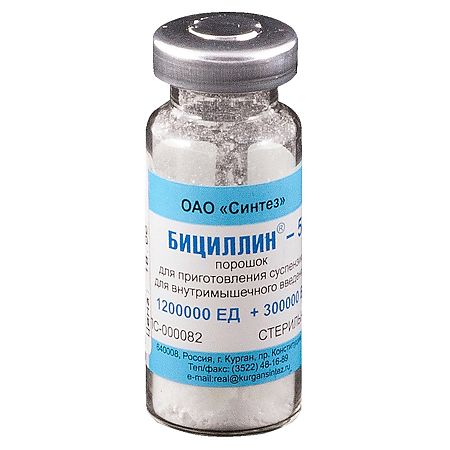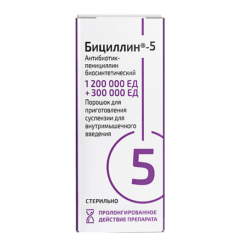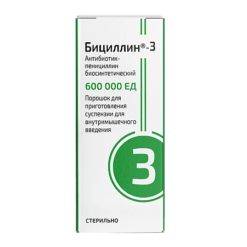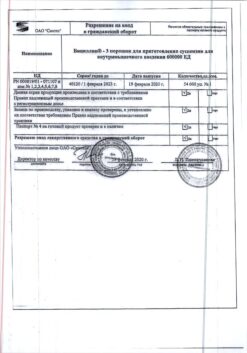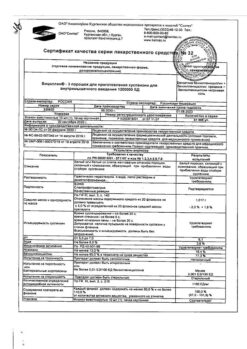No products in the cart.
Bicillin-5, 1500000 units, 10 ml, 50 pcs.
€1.00
Out of stock
(E-mail when Stock is available)
Description
Bicillin-5 is a penicillin antibiotic of prolonged action.
Pharmacodynamics
A combined bactericidal antibiotic consisting of two salts of long acting benzylpenicillin. It suppresses the synthesis of the cell wall of the microorganism. Active against Gram-positive microorganisms: Staphylococcus spp. (not forming penicillinase), Streptococcus spp. (including Streptococcus pneumoniae), Corynebacterium diphtheriae, anaerobic spore-forming bacilli, Bacillus anthracis, Clostridium spp, Actinomyces israelii; Gram-negative microorganisms: Neisseria gonorrhoeae, Neisseria meningitidis, Treponema spp.
Penicillinase-producing strains of Staphylococcus spp. are resistant to the drug.
Pharmacokinetics
Bicillin-5 is a prolonged action drug, the high concentration of the antibiotic in the blood remains up to 4 weeks.
Benzoin benzylpenicillin.
After intramuscular injection of benzothine benzylpenicillin is very slowly hydrolyzed, releasing benzylpenicillin. The maximum concentration of the drug in blood serum is reached 12-24 hours after injection.
The long elimination half-life ensures stable and prolonged concentration of the drug in blood: on the 14th day after administration of 2400000 ME of the drug the serum concentration is 0.12 µg/ml; on the 21st day after administration of 1200000 ME of the drug it is 0.06 µg/ml (1 ME = 0.6 µg). Diffusion of the drug in liquids is complete, diffusion into tissues is very poor. Binding with plasma proteins is 40-60%.
Benzathine benzylpenicillin passes in small amounts through the placental barrier and also penetrates into the breast milk of the mother. Biotransformation of the drug is insignificant. It is excreted mainly by the kidneys unchanged. During 8 days up to 33% of administered dose is excreted.
Benzylpenicillin.
The maximum concentration in plasma is reached after 20-30 minutes after intramuscular injection. The half-life of the drug is 3060 min, with renal insufficiency 4-10 hours or more. Binding with plasma proteins is 60%. The drug penetrates into organs, tissues and biological fluids, except for cerebrospinal fluid, eye tissues and prostate. In case of meningeal inflammation it penetrates through the blood-brain barrier. Passes through the placenta and enters breast milk. It is excreted unchanged by the kidneys.
Indications
Indications
Infectious and inflammatory diseases caused by susceptible pathogens: long-term (year-round) prevention of recurrent rheumatism; syphilis, yaws; streptococcal infections (excluding infections caused by group B streptococci) – acute tonsillitis, scarlatina, wound infections, rust inflammation.
Active ingredient
Active ingredient
Composition
Composition
1 bottle of powder for preparation of suspension for intramuscular administration contains:
acting ingredients:
benzathine benzylpenicillin 1200000 units and benzylpenicillin novocaine salt 300000 units.
How to take, the dosage
How to take, the dosage
Intramuscularly.
Adults – 1200000 IU + 300000 IU once every 4 weeks.
Pre-school children – 480000 iu + 130,000 iu once in 3 weeks, children over 8 years – 960000 iu + 240,000 iu once in 4 weeks.
The suspension is prepared using sterile water for injection, isotonic sodium chloride solution or 0.25-0.5% procaine (novocaine) solution.
Bicillin-5 suspension is prepared aseptically, immediately before use (ex tempore): 5-6 ml of the solvent is slowly (at the rate of 5 ml in 20-25 seconds) injected into the vial with the drug under pressure. The contents of the vial is stirred and shaken along the longitudinal axis of the vial until a homogeneous suspension is formed. Bubbles are allowed on the surface of the suspension at the walls of the vial. Bicillin-5 suspension is injected immediately after preparation deeply intramuscularly into the upper outer quadrant of the gluteal muscle.
Stretching of the gluteal muscle after injection is not recommended. Delaying the injection immediately after preparation changes the physical and colloidal properties of the suspension, which may result in difficulty in its movement through the syringe needle.
Interaction
Interaction
Bactericidal antibiotics (including cephalosporins, vancomycin, rifampicin, aminoglycosides) have a synergistic effect; bacteriostatic (including macrolides, chloramphenicol, lincosamides, tetracyclines) – antagonistic.
Increases the effectiveness of indirect anticoagulants (by suppressing intestinal microflora, reduces the prothrombin index); reduces the effectiveness of oral contraceptives, drugs, in the metabolism of which para-aminobenzoic acid is formed, ethinylestradiol – the risk of bleeding “breakthrough”.
Diuretics, allopurinol, blockers of tubular secretion, phenylbutazone, nonsteroidal anti-inflammatory drugs, reducing tubular secretion, increase the concentration of benzylpenicillin in blood and tissues. Allopurinol increases the risk of allergic reactions (skin rash).
Special Instructions
Special Instructions
It should not be administered subcutaneously, intravenously, endolumbally, or in body cavities. In case of accidental intravascular injection, a transient feeling of depression, anxiety and visual disturbances (Wanier syndrome) may occur. In order to avoid accidental intravascular injection of the drug, it is recommended to perform aspiration before intramuscular injection in order to detect possible needle penetration into the vessel.
When treating syphilis, microscopic and serologic studies should be performed before starting therapy and then for 4 months. In connection with the development of fungal infections, it is advisable to simultaneously prescribe B-group vitamins and vitamin C, and, if necessary, antifungal drugs for systemic use. It should be taken into account that the use of insufficient doses or too early discontinuation of treatment often leads to the emergence of resistant strains of pathogens.
Contraindications
Contraindications
Hypersensitivity to the drug, benzylpenicillin and other beta-lactam antibiotics. Period of lactation.
With caution: pregnancy, renal failure, aggravated allergic history, bronchial asthma, pseudomembranous colitis.
Side effects
Side effects
Allergic reactions: anaphylactic shock, anaphylactoid reactions, urticaria, fever, arthralgia, angioedema, erythema multiforme exudative, exfoliative dermatitis.
Laboratory measures: anemia, thrombocytopenia, leukopenia, hypocoagulation.
Other: stomatitis, glossitis.
Pregnancy use
Pregnancy use
Bicillin-5 passes through the placental barrier and into the mother’s milk in small amounts.
Pregnant use is possible only when the estimated benefit to the mother exceeds the potential risk to the fetus.
It is recommended to stop breastfeeding if the drug has to be administered.
Additional information
| Shelf life | 3 years. |
|---|---|
| Conditions of storage | In a dry place at a temperature no higher than 20 ° C. |
| Manufacturer | Sintez OAO, Russia |
| Medication form | solution for injection |
| Brand | Sintez OAO |
Other forms…
Related products
Buy Bicillin-5, 1500000 units, 10 ml, 50 pcs. with delivery to USA, UK, Europe and over 120 other countries.

